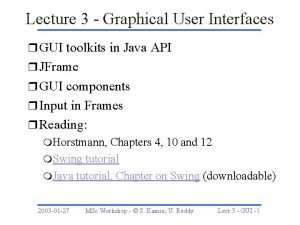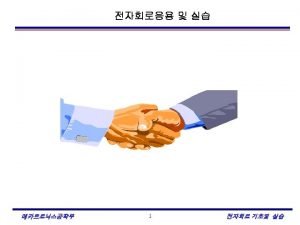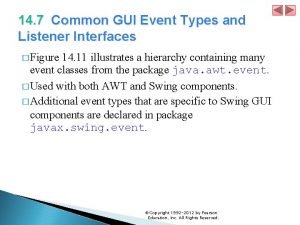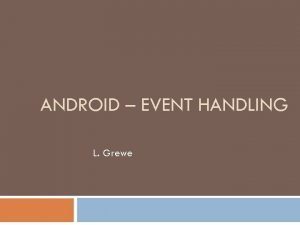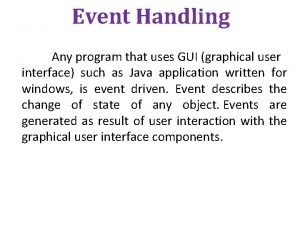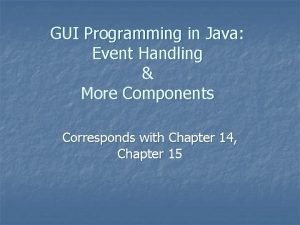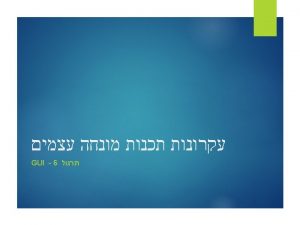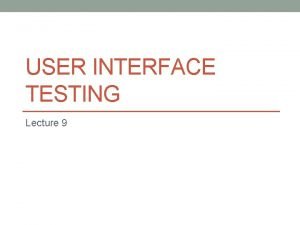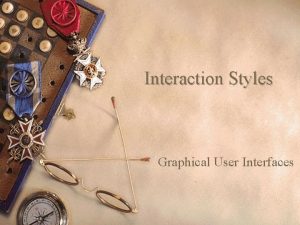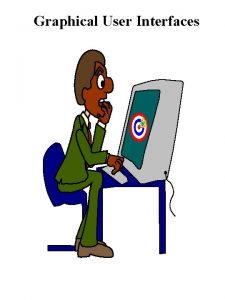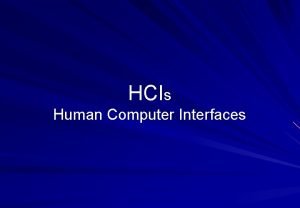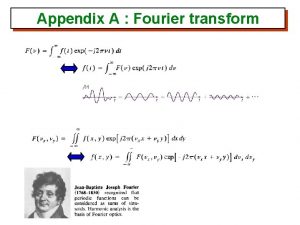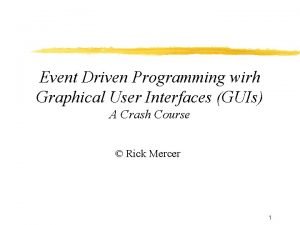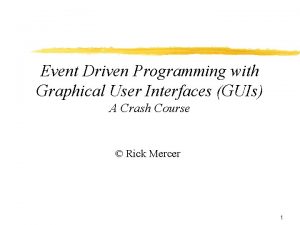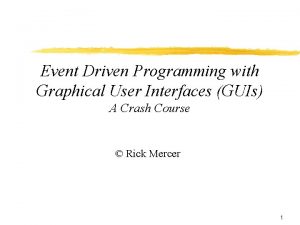Graphical User Interfaces Event Handling Appendix C Graphical















- Slides: 15

Graphical User Interfaces Event Handling Appendix C

Graphical Applications • Graphical application consists of a high-level window that contains components which the user can interact with • The java. awt and javax. swing packages contain classes for building graphical applications – the swing classes are newer

Class Hierarchy

Components • Objects that are displayed on the screen • User interacts with components by clicking the mouse (or sometimes, typing) • Components generate events – each component that generates an event needs to know where to send it • Containers are a subclass of Component – Containers can hold other Components

Stand-alone Window Classes • Top-level container classes – JFrame, Frame – Dialog, JDialog – JWindow • We will use JFrame

Event Handling • Most components can generate events • java. awt. Event is the superclass for all events – – Action. Event Item. Event Mouse. Event … • Each component that generates an event needs to know what listener to send the event to

Listener Interfaces • Each event class has a corresponding Listener interface – – Action. Listener Item. Listener Mouse. Listener … • When you create a component, you need to tell it which listener should get the events it generates – the component classed have add___Listener methods for doing this

Action. Listener public interface Action. Listener extends Event. Listener { public void action. Performed( Action. Event e); } • Any class that implements this interface needs to define the action. Performed method which has code to execute the desired response to the event.

Listener classes • Examples from text create inner classes that implement the appropriate listener interface. – see PDButton. UI. java • Another approach is to have the container class that holds the components implement the listener interface. – see GUIApp. java

JFrame • Create a GUI application by writing a class that extends Jframe • The constructor contains code to add all the desired components and register the appropriate listener for each component.

JPanel • JPanel is a light-weight container that can be used to organize a set of related components. • As with JFrame, you can create your own panel class that extends JPanel. • A JPanel can also be used as a drawing surface

Layout Managers • • • Border. Layout (see Border. Layout. Demo) Flow. Layout (see Flow. Layout. Demo) Box. Layout (see Build. Box. Layout) Grid. Layout (see Grid. Layout. Demo) Card. Layout (see Card. Demo) • There are other layout managers.

Combining Layout Managers • For a complex application, the layout managers may not do exactly what you want. • You can add one or more JPanels with different layout managers to your main container to get more complex arrangements of components

Data Entry Components • JCheck. Box (see Check. Box. Demo) • JRadio. Button (see Border. Layout. Demo) – To work together, JRadio. Buttons need to be added to a Button. Group • • JCombo. Box (see Combo. Box. Demo) JText. Field (see Text. Field. Demo) JText. Area (see GUIApp) JLabel (see Text. Field. Demo) • … http: //java. sun. com/docs/books/tutorial/ui/features/co mponents. html

Building Menus • JMenu. Bar – A JFrame has a JMenu. Bar associated with it • JMenu – Add JMenu objects to the JMenu. Bar • JMenu. Item – Add JMenu. Items or JMenus to a Jmenu • See Draw. App. java
 Programming graphical user interfaces in r
Programming graphical user interfaces in r User interfaces design dc
User interfaces design dc Characteristics of web user interface
Characteristics of web user interface Why are user interfaces hard to implement
Why are user interfaces hard to implement Heuristic evaluation of user interfaces
Heuristic evaluation of user interfaces Gui events
Gui events Android event handling
Android event handling Java gui event handling
Java gui event handling Event handling in ada
Event handling in ada Java event handler example
Java event handler example Swing layouts
Swing layouts Graphical user interface examples
Graphical user interface examples Characteristics of graphical user interface
Characteristics of graphical user interface Graphical user interface testing
Graphical user interface testing User interface history
User interface history Jpanel
Jpanel
